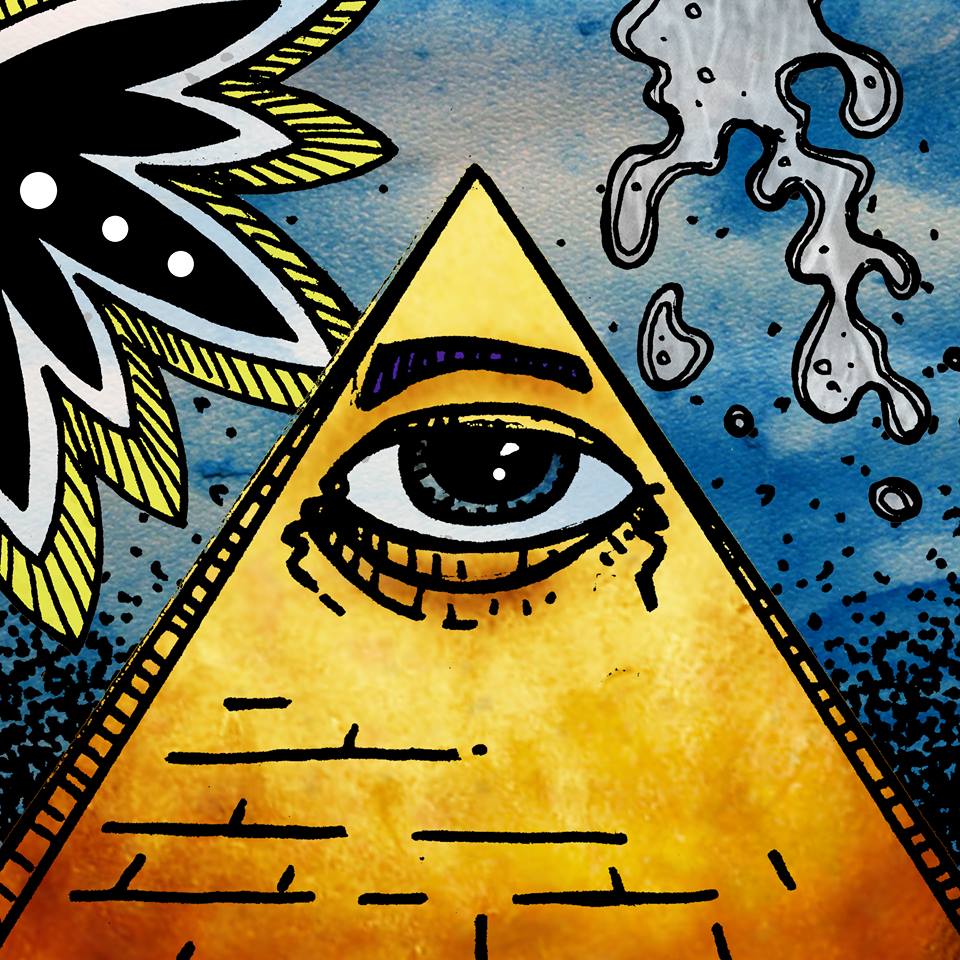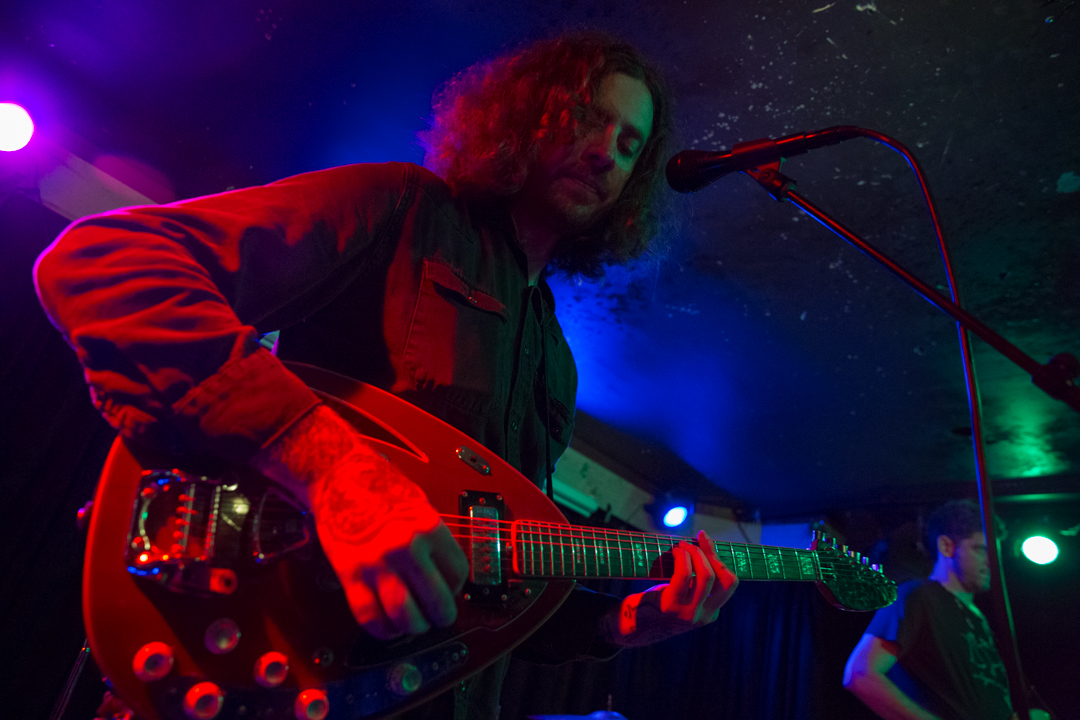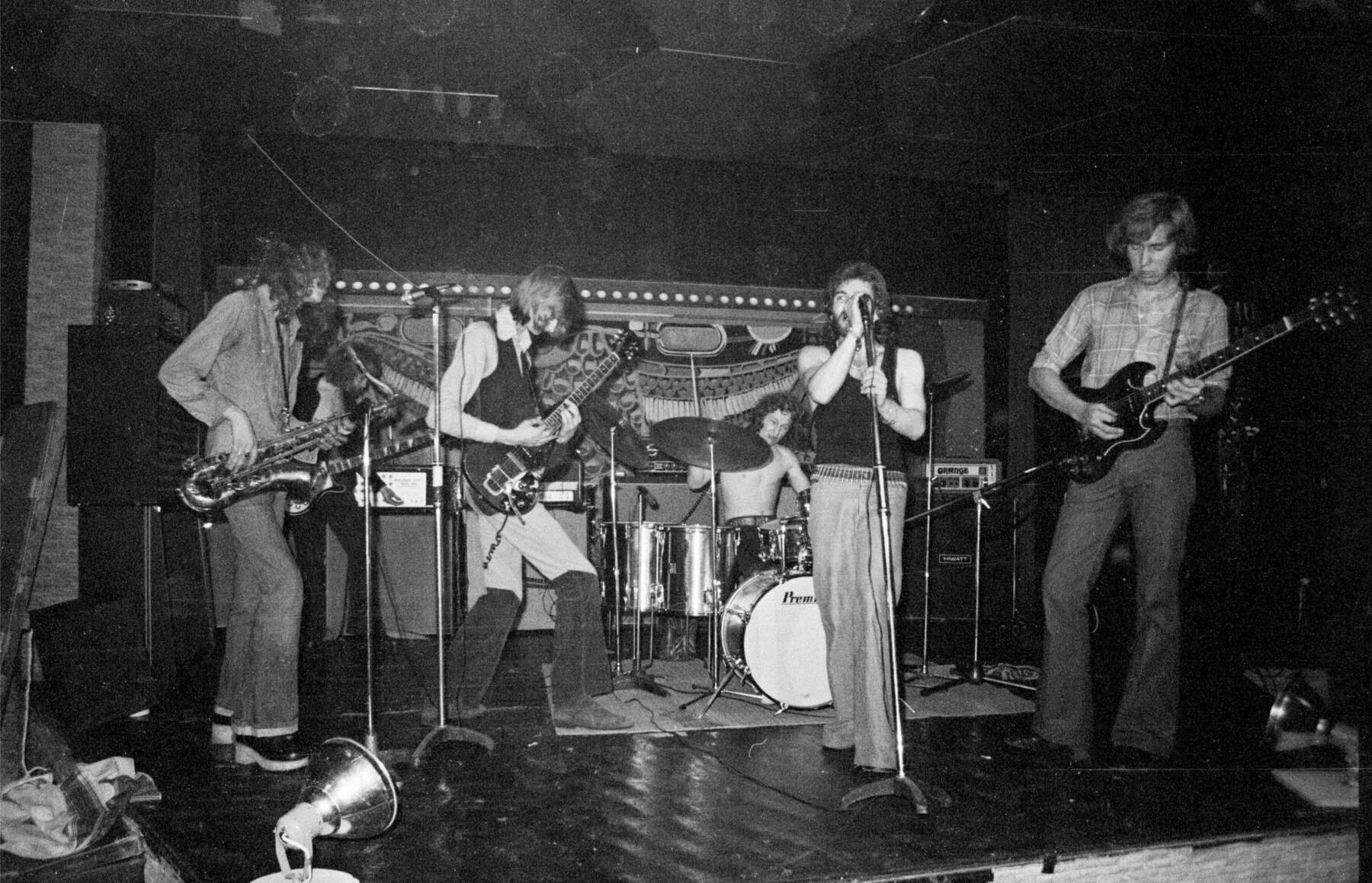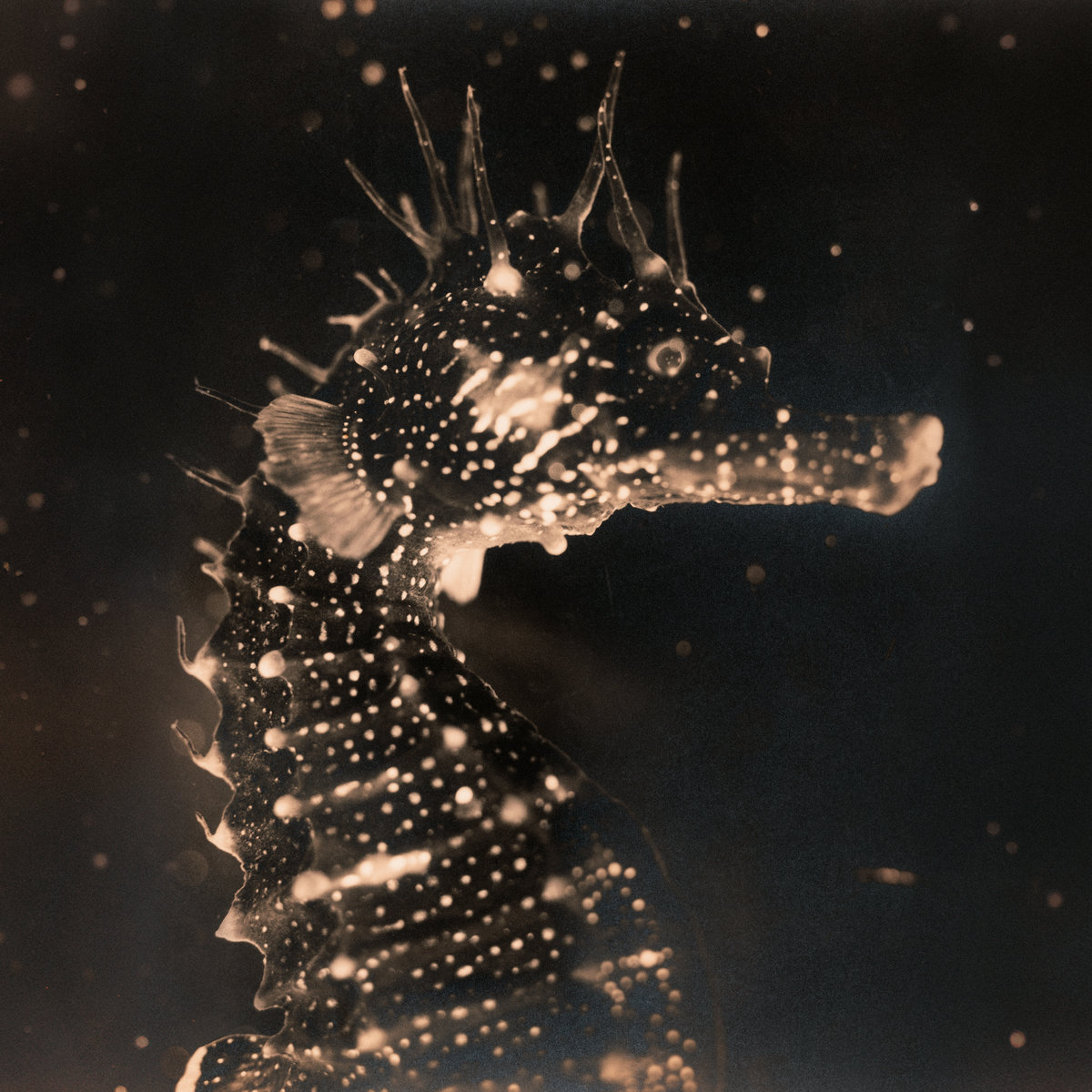Neon Lemon Tune In: ‘Hypnagogic Visions’ and Other Realities
Neon Lemon out of Austin recently dropped ‘Hypnagogic Visions,’ a hazy psych trip released on UK label Feral Child.
The 10-inch is full of dreamy, blown-out rock that feels like it’s drifting in from another frequency. It’s the kind of record you might find on a dusty reel in the back of someone’s attic and wonder how it ever existed.
Now they’re back with a new 7-inch, ‘Sunflower’ and ‘Higher than Heaven,’ recorded at Wall of Fog with Xavier Juarez and mixed by Kate Derringer of Detroit’s Shadow Show. This one marks the first release with their current lineup. Expect a sound warm and warped like tape left too long on a dashboard, humming with the heat of the Texas sun.
Neon Lemon pull their influences from the deep end of the crate. The Monks, Os Mutantes, Sandy Bull, The Impressions, Gainsbourg, Can. All filtered through a flickering memory of Texas psych. It’s not pastiche. It’s possession. They treat history like a tuning fork, striking it gently and listening for the right kind of shimmer. Their playing has that beautiful, dangerous looseness, like it might crumble at any second but somehow holds together, levitating just above the floor. It’s the kind of sound that leaves you sunk into the couch, drifting into hazy dreams of late 60s nights.
There’s also talk of more from their collaboration with Mr. Franklin, though they’re keeping it cryptic. Neon Lemon feel less like a band trying to keep up and more like one tuning into a deeper signal. Easily one of the most interesting groups in the current psych underground.
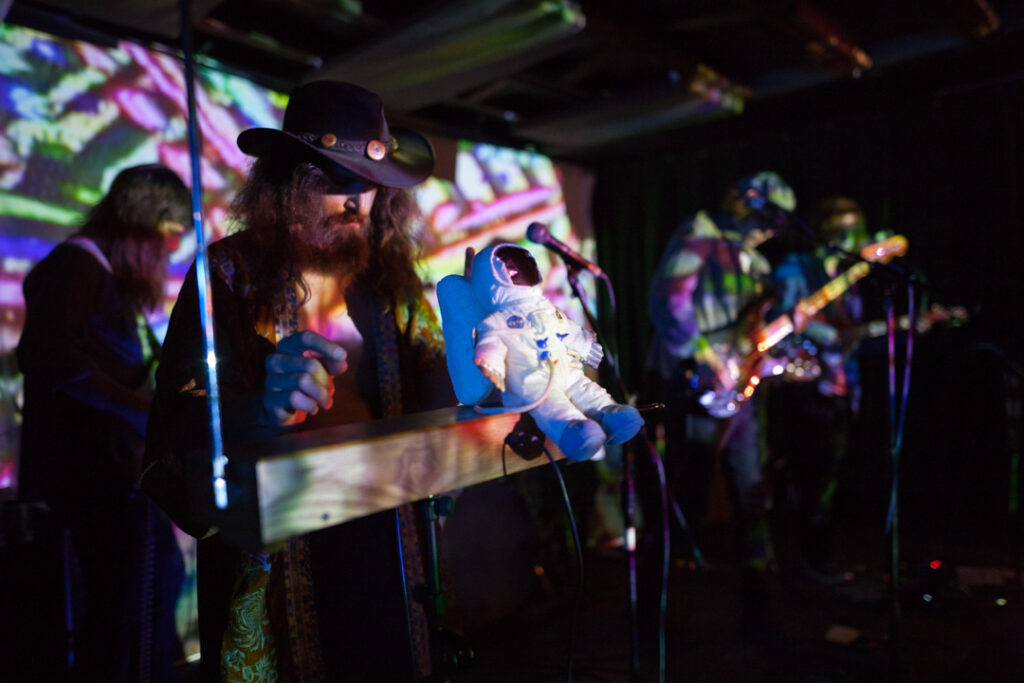
“You guys are the most psychedelic band of all time, second to Red Krayola.”
Let’s start with some roots—where did you all grow up? What was the DIY music scene like when you were coming up, and were you a part of it in any way?
Ben: Wamego, Kansas. The person I was tattooing under went to school with Nate Ryan from the early days of The Black Angels, and when they came to town in 2005, it opened my mind to music like that. When we moved to Wichita, there was a house with multiple floors, and everyone was playing music on different floors of the house and kind of tripping or whatever on a different vibe. It was a very rich, psychedelic environment, and that’s where I got into Spaceman 3. From there, everything kind of changed. My deep dive into music really took off at that time. I think I was around 20 then.
Chris: Deer Park, Texas, a suburb of Houston. I don’t remember Houston having much of a scene that interested me, but right down the road in Austin, you had bands like The Black Angels, Woven Bones, Shapes Have Fangs, Rayon Beach, and The Strange Boys doing psych garage style music mixed with a little punk. I was in a 60s/70s punk style band playing a cheesy Vox organ, but I still feel like we aligned with Austin much more than Houston.
Ethan: Austin, Texas. The DIY scene was mostly free house shows that you could bike to, and it was fun. Austin was much more centralized back then. These days, there is more of a north/south split with the venues. I did college radio at UT and met most of my lasting college friendships there pulling graveyard radio shifts. Every week, there was a live band in-studio on a program called Local Live. I would always be there for setup running cables, stick around, and then stay for all the DJs afterward until my show at 3 AM.
Cody: San Marcos, Texas. When I was really coming up playing in bands, I was in San Marcos. San Marcos had one of the most vibrant DIY communities in our state, honestly. There were house shows nearly every night—just music all around, it’s a college town. Just a bunch of young hungry musicians trying to do stuff, and I was playing in a band and we were doing that. It was really cool. There was like a little posse of San Marcos bands just keeping stuff together. Grady Roper from Attic Ted was really important, as were Stoop Queens, Moon Dunes, Bogan Villa, and then of course The Lucies. Coming into Austin, I was inspired by the venue The Electric Church, who turned out to be homies. Like in 2016, that was the sickest place ever. Then after the pandemic, we ran our own space, The Inner Chamber.
Shawn: I grew up moving back and forth between central California and central Texas. As a young adult, I was living in a beach town called Santa Cruz in California. Most of the live music there at the time wasn’t necessarily the scene of the music I liked. It was mostly reggae, ska, or hip hop. I generally went up to San Francisco or Oakland to see psych rock bands or the stuff that I would like. As a kid, I lived in a small town outside of Austin, and still had family there, so I was still consistently going to Austin. While living in California, Texas always had a special place in my heart. I started going to Austin Psych Fest in 2013 and realized the psychedelic music scene was in Austin, so I ended up moving here.
Austin has such a deep psychedelic history—from the Elevators to the whole Vulcan Gas Company scene. When did you first hear the 13th Floor Elevators, and what kind of impact did they have on you?
Ben: The first time was around 2005, right before I saw The Black Angels for the first time and was hearing all these stories from the people that taught me how to tattoo. The impact of hearing the Elevators for the first time was “what the fuck is that jug sound and why are the songs so good?” They had that early soul rock and roll quality, but just something special, which I didn’t know at the time was the beginning of psychedelic music. It was like Roky’s voice had that Eric Burdon vibe but was truly something unique and different. I think watching the documentary Dirt Road to Psychedelia always stuck in my mind—just walking around in Austin when I first moved here, knowing that this ground was a spawning point for something like that always blew my mind and inspired me in many ways.
Chris: I first heard them in high school. They quickly became one of my favorites, especially considering they were from Texas, and peaked my interest in finding other Texas psych bands. To this day, ‘Bull of the Woods’ remains one of my favorite albums of all time—even if Roky wasn’t fully involved at that point.
Ethan: I first heard the Elevators in high school art class. My teacher had a vinyl collection that she kept in the studio and it was a bunch of 60s stuff. She had the first album, and I just remember liking it and having a very strong association with Austin because of it. I didn’t really understand the historical significance; I thought they were just a lesser band from Austin, lesser compared to The Rolling Stones, The Beatles, and other 60s bands. I thought they were some little band that didn’t really make it or something, which I thought was very unfair, because I really liked their music.
Cody: I was just hanging out with my buddy Travis, taking large amounts of acid and listening to music. He exclusively listened to obscure 60s psychedelia. I shared synthesizers with him, and he shared a really useful lens of music with me. We just listened to the first album on acid, and then our band at the time covered “Rollercoaster” along with other adjacent songs. I just thought it was really cool. Same as Ben, “how did they get that song?” We were trying to understand jug bands and find lost videos of jug bands, and it really opened me up. It made me take psych bands seriously—like this is serious stuff.
Shawn: I probably first heard them when I was around 20. It was around the time I was diving deeper into psychedelics and psychedelic music. Both their music and lyrics really stood out to me. Not many musicians were talking about the things that they were talking about. Lyrics about reaching higher consciousness just really stood out to me. Roky was definitely the voice behind The Elevators, but their jug player Tommy Hall and friend Powell St. John wrote most of their lyrics, at least for their first two albums. Stacy Sutherland took over for ‘Bull of the Woods’ and is still great, but I feel it lacks the lyrical beauty of the first two albums. I also love weird instruments, so the electric jug stood out to me pretty instantly. Growing up around Austin also made it resonate a little more at home.
What about other psych bands from that golden era—Shiva’s Headband, Golden Dawn, The Red Krayola—any favorites? And what about beyond Texas? Who really blew your mind early on?
Ben: Like early on, the Butthole Surfers came out with that song ‘Pepper’ and I remember hearing that at the swimming pool because it was on the radio all the time, and just going, what the fuck is this sound? That kind of sent me to Austin, Texas. But also I grew up in a town where the Leonard Pickard LSD lab was, too, so I think there was something going on there. But the Golden Era bands? Besides the 13th Floor Elevators, definitely hands down my favorite from that era. The Beatles and the Beach Boys would be my introduction and the Velvet Underground, too. Dark art rock music. So for me, that dark scary psychedelic music vibe was kicked off by hearing the Butthole Surfers, then I went to the Velvet Underground, after that to the Beatles, then it kind of went in a circle. It was like, this is the scary, dark, seedy, fuckin cool shit. And it’s always been there. The Velvet Underground has always been that pentacle of real gnarliness that only someone who has been through real shit can go to. Maybe it was the Warhol vibe. Another band, Donovan, has that fucking dark scary vibe too.
Chris: I remember really falling in love with Golden Dawn because Power Plant had so many great songs with elements of psych that I had not heard up to that point, which led to other bands like Ultimate Spinach and United States of America, a West Coast Experimental Pop band. At the same time I grew up loving the Doors, which also led to other bands like Velvet Underground. They all tied together in this spectrum between light and dark.
Ethan: In high school I was into The Velvet Underground as much as anything. They were the band that hit me emotionally the hardest, for the same reasons others have said. It was so obviously songs written from real life and something that wasn’t faked, and they were really going for it. They wanted to be original and took it so seriously. I think that band practiced close to every day. There was this marriage of avant-garde with John Cale, and then Lou Reed, whose chord progressions were often very pop, even though minimal. I was into 50s and 60s jazz a lot, which I think is psych adjacent, especially the drums and the improvisatory aspect of it. Later I got into the Electric Prunes, who I think are criminally underrated.
Cody: Well, you mentioned the Red Krayola. I remember the first time I heard them. There was this guy who came up to my band in San Marcos, and he was a really big fan of us. He was maybe in his mid-fifties. He gave me this CD that he just wrote on called “music to trip to” and it was just like ‘The Parable of Arable Land’. He said, “You guys are the most psychedelic band of all time, second to Red Krayola.” I was just like, I don’t even know who that is. But they were super cool. In terms of other music, my dad was a DJ. I grew up just surrounded by music that I felt like was blowing my mind. Just a lot of funk, soul, and jazz in the early years, into Jimi Hendrix. Just listening to him playing ‘Killing Floor’ live was like pswhooo, getting my mind melted at five or six years old. Steve Reich now will blow my mind just like 15 minutes into Caution Gator Feedback by the Dead, you know?
Shawn: When it comes to Texas, gotta say the 13th Floor Elevators, Golden Dawn, and Cold Sun. Growing up, it started off with earlier mainstream psych stuff like Pink Floyd, Jimi Hendrix, Jefferson Airplane, etc. Pink Floyd always stood out in particular and will probably forever stay my favorite band, especially their earlier works. Live at Pompeii is one of the coolest musical things ever done. I have also always been into the heavier, fuzzed-out, dronier music like Spacemen 3, Wooden Shjips, and Dead Meadow. Then as time went on, I started to find more far out obscure stuff like Ultimate Spinach, 50 Foot Hose, Brainticket, Acid Mothers Temple, Silver Apples, and other freakout rock bands. Then later I got synthesizers and really started to get into cool electronic music. Mostly starting off with the 70s German electronic scene and finding groups like Neu, Cluster, and Harmonia. Then I started to find more obscure electronic music like Bruce Haack, Suzanne Ciani, Mort Garson, and such.
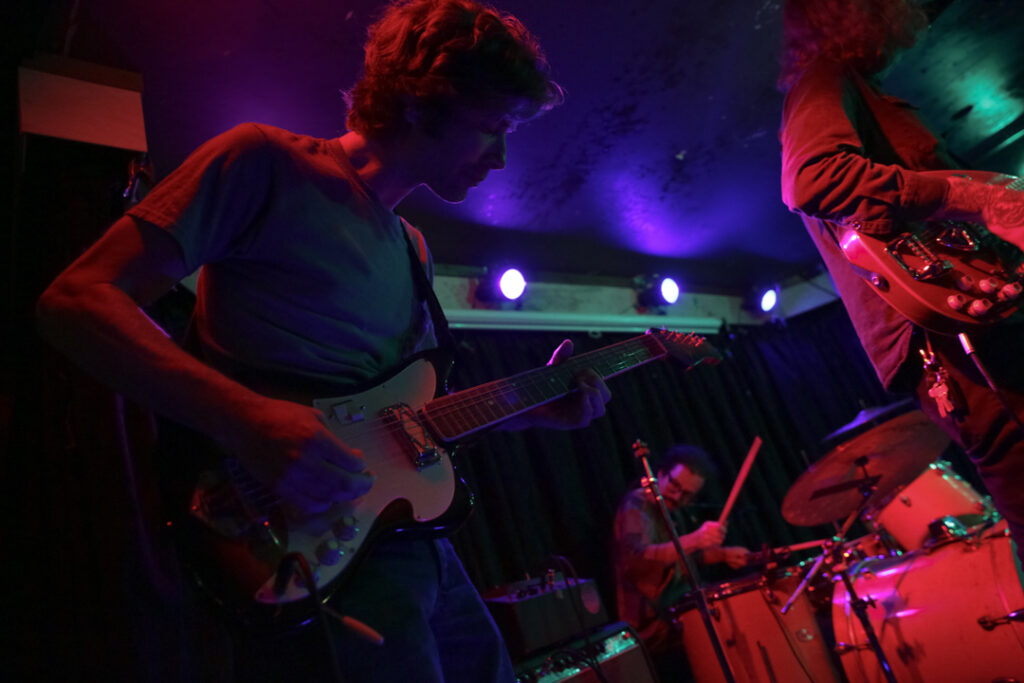
Did you grow up with access to those records, or was it more of a crate-digging, find-it-on-your-own situation? Were there particular records or discoveries that shifted your perspective on making music?
Ben: No, I definitely did not grow up around music like that. I grew up around, like, my mom loved John Lennon and my dad loved The Doors. That was his favorite band. Those two things kind of combined my thought process, but I remember in the 90s specifically hearing a Sneaker Pimps song, ‘6 Underground,’ and I remember hearing Massive Attack, ‘Mezzanine,’ and those kinds of sounds got me into, I think, what I do today musically. Just that kind of dark, trancy music. I kind of like, what’s that movie, Trainspotting, like that kind of stuff. Just gnarly underground, dark vibes. After that, I then met people that kind of got me into better music that was from the 60s and better music, listening to the Velvet Underground and also listening to Tom Waits and Nick Cave and the Bad Seeds and that stuff, and I was always drawn to that Murder Ballads album. Also Sam Cooke’s ‘One Night Stand’ live record has always been a favorite of mine. Something in the way he chuckles after certain lines, showing maybe a different perspective on subjects he initially wrote the songs about.
Chris: Yes, I could go downtown in Houston where there were a few good record shops, too bad I had no money, so a lot of my first records were purchased at thrift stores. In my early high school days, I was more obsessed with goth music. I wanted to buy a synthesizer because I was more into bands like Bauhaus and Sisters of Mercy, but what shifted my focus was seeing Brian Jonestown Massacre in DIG. I ended up grabbing a guitar instead of a synthesizer.
Ethan: I did not have access to records in high school really. My early listening was Z102.3 classic rock radio in my dad’s car. I miss that format, it was mostly 60s and 70s. The most records I saw were in that art class, but I took her class for three years in high school. I forgot to mention Jimi Hendrix. The first time I smoked pot I went upstairs and played guitar, and I swear I felt like I was channeling Jimi. He was my first musical hero. I wanted to get as good as him, and I’m glad I had the ignorance to try because it got me through the first few years of practice on my guitar. I really listened to almost entirely mainstream music through high school. The Strokes and The White Stripes were really big, also the Yeah Yeah Yeahs. I really got into indie music from going to shows in college. I was able to go to shows for free through the college radio station and a label I did mail-order for as an intern. I was going to shows probably five nights a week the first couple years of college. So for me, the energy of discovery was more tied up in the live performance than it was in the records. Usually I would get into a band’s record after seeing them live. One band I saw a lot in college and continue to try and catch whenever they are in town is Acid Mothers Temple, who I would probably call my favorite band, for whatever that is worth.
Cody: I forgot what albums I have referenced already, if I referenced any earlier, but like I said, I grew up around what I consider really good music, but there was a period of time that I wanted to rebel to that. I didn’t want to just listen to my dad’s music, even though it was really good, so I went online into forums and read people’s opinions about music I had never heard of, and I found music that no one around me was listening to. That might have been a little cringe, some of it, a lot of what was happening in the 2000s in the indie scene, things like that, but then I circled back, I came back and went deeper in. I started playing jazz in bands in high school and fell down the hole, the endless pit of harmony, experimentation, collaboration, exploration. Hearing ‘Bitches Brew’ the first time in high school, later hearing Sun Ra and discovering Steve Reich, those hugely affected the way I think about music.
Shawn: More of a find-it-on-your-own thing. Going to high school in a small little town in Texas, nobody really listened to good music. Me and a small group of friends were the stoners of our town, so we went out and found music we liked starting with the Beatles and Led Zeppelin and such, and just went from there. Then I moved to Santa Cruz and had friends expose me to good modern music like The Black Angels, Dead Meadow, Spacemen 3 and Wooden Shjips, which I had not heard yet. It really got me into the distorted fuzzed-out sound and that became one of my biggest influences in making music. Then I moved to Austin and actually found like-minded people who were into a similar sound and started making music with them.
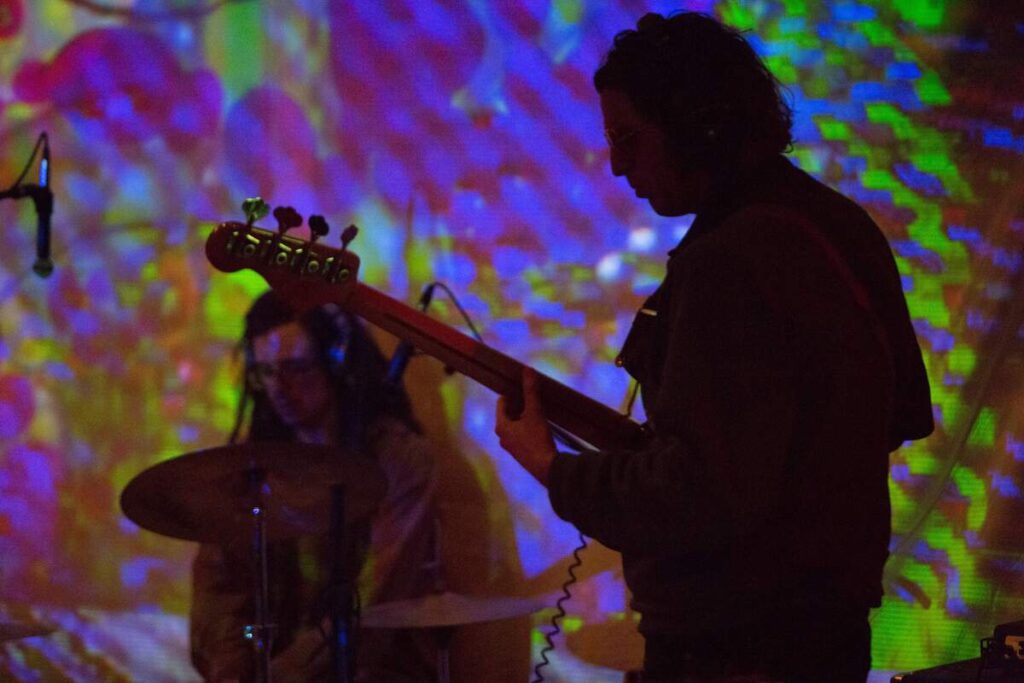
“It was a metaphysical ritual”
So let’s get into ‘Hypnagogic Visions’. This 10” seems to capture a real rawness, almost like a séance recorded live. You mentioned The Inner Chamber as the place where it was recorded. What was the vibe like in there? How much of the record came from spontaneous jams versus structured songwriting?
Ben: The vibe of The Inner Chamber when we went there was intense. I can feel personally I was going through a lot of heartache. My best friend had overdosed on fentanyl and I lost him, and I also went through a separation with my daughter’s mom around the same time. Chris had been going through some stuff too. His friend had committed suicide around then as well. There was a bunch of dark stuff going on. I was losing a relationship and turning to taking a lot of drugs. I was on opiates again and whatever I could find to numb myself and feel like I could create. Chris and I had made some songs after our last record, and Levi and Cody had joined. We were finishing these songs we were in the process of cultivating at that time. So the songs were structured. We were in the process of writing them, and by the time we ended up recording these songs at The Inner Chamber, we had structures for the songs down and we were playing live shows. We would set up mics, amps, and record things in live takes, and attempt to do some overdubbing here and there. We loved the sound of the warehouse we were in. The ceilings were 20 some odd feet tall, and it had all the gear we all had set up. It was a great escape. ‘Love So Pure’ was the only song recorded solely at Mr. Pink Recording Studio. We practiced that song I had wrote about my current relationship with my daughter’s mom once the night before going in. Oddly enough, we finalized our separation the day we recorded that song. So the album was originally live takes in that space recorded over a period of days, and then once we had everything recorded we decided that we needed to go to Jonas Wilson, who I had previously done ‘Look Outside’ with. We ended up rerecording the drums, which was a feat because we didn’t get the best drum sound originally. Although part of me thinks that live recording at The Inner Chamber captures something, there is a blend between the two.
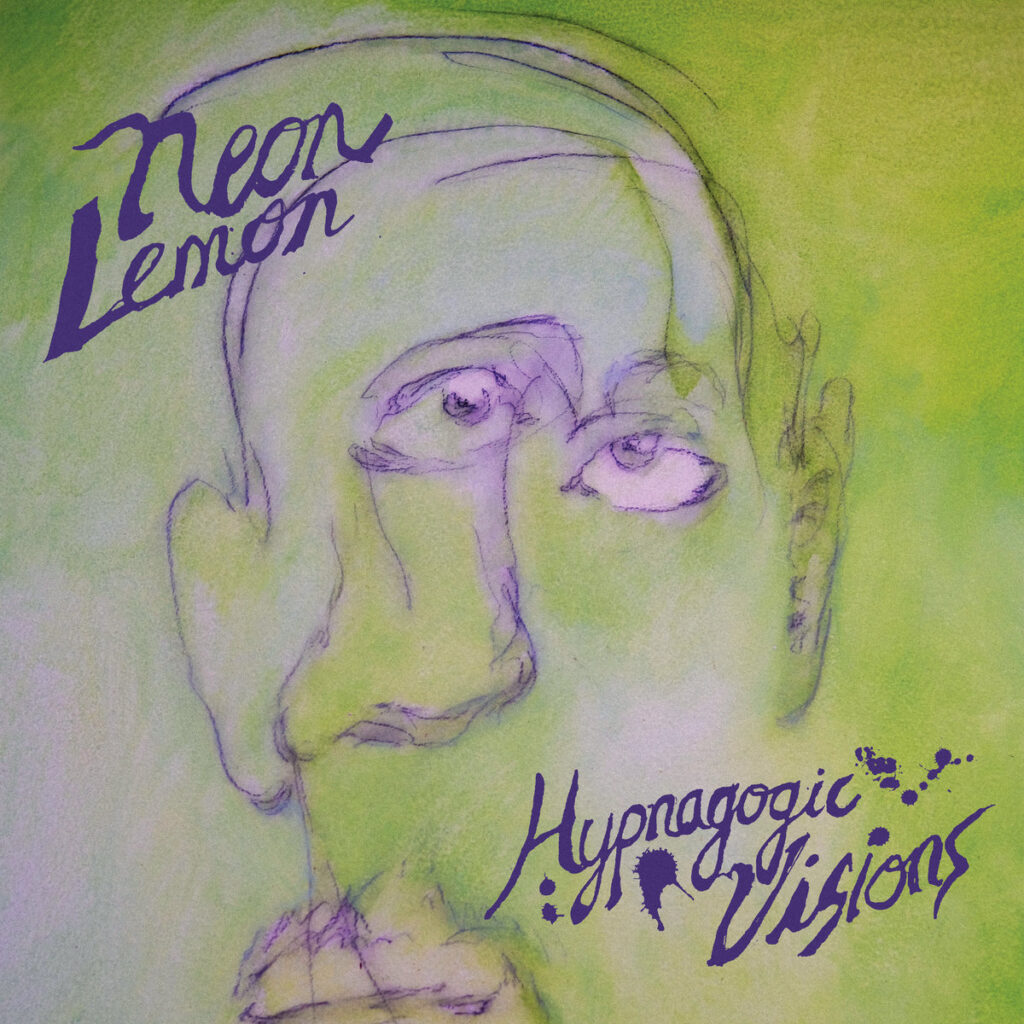
Chris: I was broke during that time, so going to The Inner Chamber and recording was like the highlight of my life. I rarely play the same riff every time we play a song, so the takes that were captured are based on my feelings in the moment. But I felt very creatively free to do that, and everyone in the group accepted that’s the way I play. It was a really great experience throughout the entire thing. I love that we recorded it raw at the place where we really grew together as a band.
Ethan: I wasn’t in the band yet. Levi Murray, who is still a friend of the band, played bass. I joined the band learning his bass lines from this record. I am super stoked it’s on vinyl because I think the bass hits harder. It was sort of like listening to it fresh for me. I only made it to The Inner Chamber once. It was their last show actually. It was a bit of a drive for me, out 183 at the very end of William Cannon. It was pretty loose. I was painting on the wall. There was food, and upstairs there was a ball pit like at Chuck E. Cheese’s. There was a big parking lot and some food trailers next door, so there was kind of some space if you wanted to get away from it all.
Cody: So, ‘Hypnagogic Visions’ was a séance. It was a metaphysical ritual, and it was to expel those songs out of our bodies and to finally capture them somewhere else other than the abstract of what we had been doing for a year leading up to it. The Inner Chamber was the perfect place to do it because it was inside of my womb, the womb of my mind, and a place that felt like it was closer to home for me creatively. It felt like you could do anything you wanted to do creatively in there. It was a big black box that you fill with pretty lights and projections. You could close the big bay door and just watch time outside of it slip into nothingness. We could smoke DMT and just set up Logic and throw this together as simply as possible to capture that unique space. The ceilings were so high, and it just sounded so huge in there. You could hear everything perfectly, which was crazy. It was just cool.
Shawn: The Inner Chamber definitely had a great vibe and was a fun place to do our album. Being able to record in a place our friends were running was pretty awesome. You had no feeling of anxiety or being rushed like going into a regular studio. It was a cool place just to hang out and to play or watch shows. There was a collective mural that people painted on the wall that was very cool and definitely added to giving it more of a home vibe. I joined the band right before Hypnagogic Visions was beginning to be recorded. Since I’ve been in the band we’ve always had the structure of having a basic concept to a song but having room to do what we want with it and play it slightly differently every time to keep it fresh.
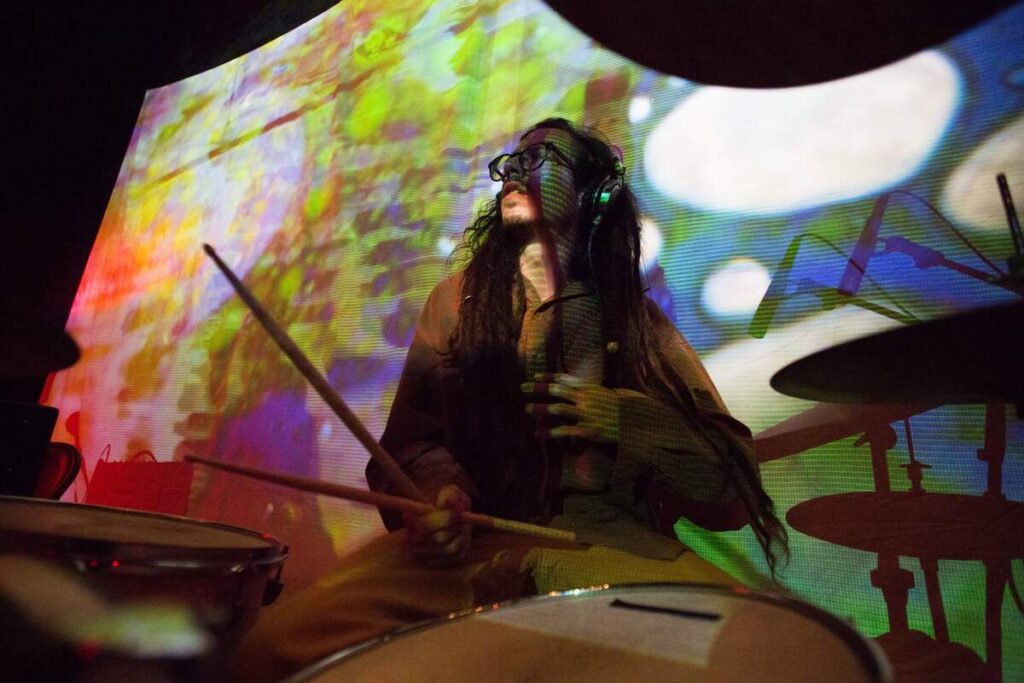
With a name like ‘Hypnagogic Visions,’ was there a certain mindset or headspace you were trying to tap into? Is the record meant to feel like an altered-state experience?
Ben: ‘Hypnagogic Visions’ the album was written, and then HV was more of Shawn’s idea for the title which maybe came out of listening to it back. It was more a reflection of what we had done and he came up with the name which I think was very smart and fitting. It allowed us to have an art direction that led to Jim Franklin’s album cover, the blindfolded self-portrait and text by Fez Moreno. It sums up how dissociative that album actually is.
There’s a heavy fuzz and drone feel to this one — like a balance between full-throttle psych and something more atmospheric. Did you have any sonic touchstones or references while putting this together?
Ben: What would Velvet Underground do, or what would Spacemen 3 have done, or like that at the time — yeah, Suicide, Dead Meadow. Bands that we were into at that time were a touchstone, but I think at the same time personally I was trying to create music with a lens of what was going on in our lives at the time, and not make it so specific to exact moments, but have it be more like it’s encrypted.
Cody: For me it’s a little different, but drum style wise, I’m not playing like any of these bands’ drummers the whole time, but I am literally, I feel like I have absorbed all these different influences and I created this drum sound for this particular band, I don’t use it anywhere else.
Shawn: On this record I mostly did theremin, cello, and synths. I was going for keeping some sort of flowing soundscapes in the background of the songs. Bands like The United States of America, West Coast Pop Art Experimental Band, 50 Foot Hose, and Red Crayola were a big influence on that. Subtle weird sounds in the back of songs really add a truly psychedelic touch to it.
Chris: Everything I play and my guitar tone is a mixture of elements from blues, country, garage, surf, and psych so that’s what I strived to add to the record.
Jim Franklin did the sleeve design, which is wild considering his history with the Elevators and Vulcan Gas Company. How did that connection come about? Did he have any thoughts on the music?
Ben: So we were in the studio finalizing the mixes and we were thinking about who we could get to do the artwork, and our friend Garrett Anderson from The Holy Temple had recently been hanging out with him and suggested it, and Shawn was like, hey do you think there is any way we could get Jim Franklin to do the artwork? We had to go to Flamingo Cantina and meet him a couple times, and kind of court him, and we ended up getting more than just the artwork for the album, we just became really good friends with him and collaborate to this day with him doing music.
Shawn: I think it depends on the type of set we play. He generally really enjoys our music, but we’ve had times when we’ve been so loud and fuzzed out that we scared him away and literally pissed him off. We have been making a record with him of his music though that we’re almost finished with. He’s always happy with that and has a good time doing it. He has had songs written for years that had never been recorded, so we have been recording an album with him and his friend Alex as his backup band. Definitely a different vibe than the music we normally play but that makes it fun. His songs originally have more of a folky feel to them, and we have our sound naturally so it comes out as some far out folk.
Ethan: The first eight times I met Jim he didn’t remember my name or recognize me, or he was pretending not to. I was unsuccessfully trying to get him to do my old band’s album art, and I would harass him down at Sam’s Town Point. But once I linked up with Neon Lemon and we jammed, he said he really liked my bass playing, and suddenly he would remember me (although it was still a few more jams before he could remember my name). We practice about an hour out of Austin, in Kyle, Texas and as one of the two Austinites in the band, I’ve had the pleasure of occasionally driving Jim to practice. He is an amazing storyteller, and I’m never surprised at the stories he tells. They are almost all completely wacky and you know they are true. It’s amazing working with a living legend. There is no one in town I would rather be making music with and learning about music from. True music. He is the OGest of OGs.
Cody: Jim Franklin said we are the absence of music and said we are nowhere close to that of a Hank Williams. But he has also just sat through the whole thing and just gone like “yeah!” and really gotten into what we are showing him.
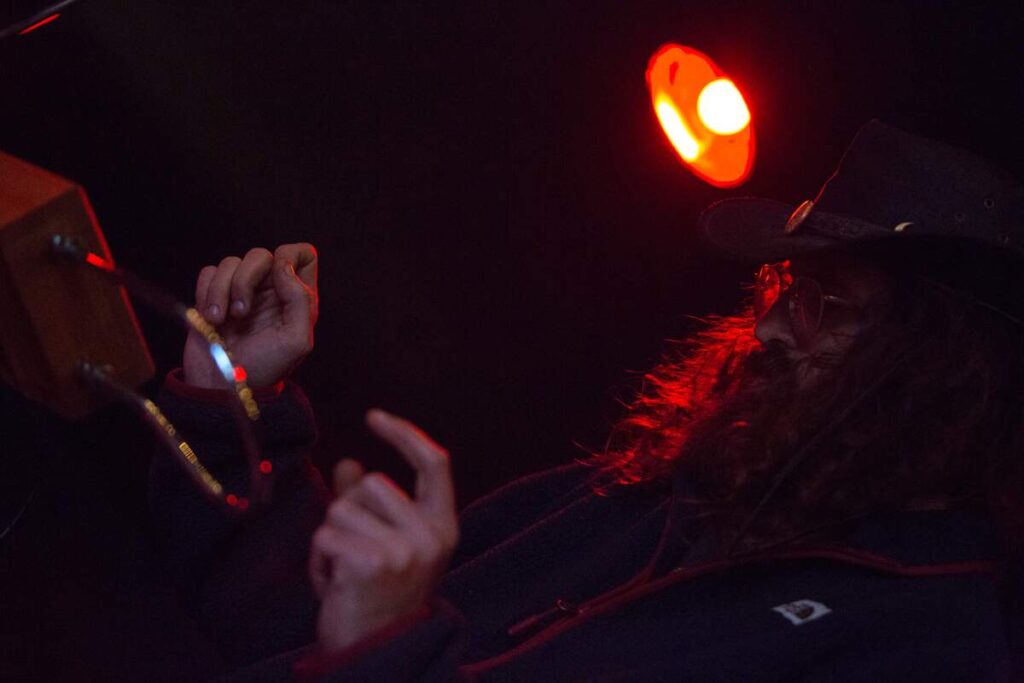
Your previous album ‘Good Vibrations’—how does that compare to Hypnagogic Visions? Is there a direct lineage between the two, or did you take a different approach this time?
Ben: ‘Good Vibrations’ was me, Chris, and Michael Haynie. That was all recorded to Tascam 388 live takes with some overdubs on whatever we had left on the 8 track. We also mixed and mastered that. After that album was recorded, Michael left the band to follow other endeavors, and our friend Jake Garcia suggested Levi to us as a bass player. Levi came and ended up joining the band and suggested Cody, who became our drummer and introduced us to The Inner Chamber, and then later to Shawn.
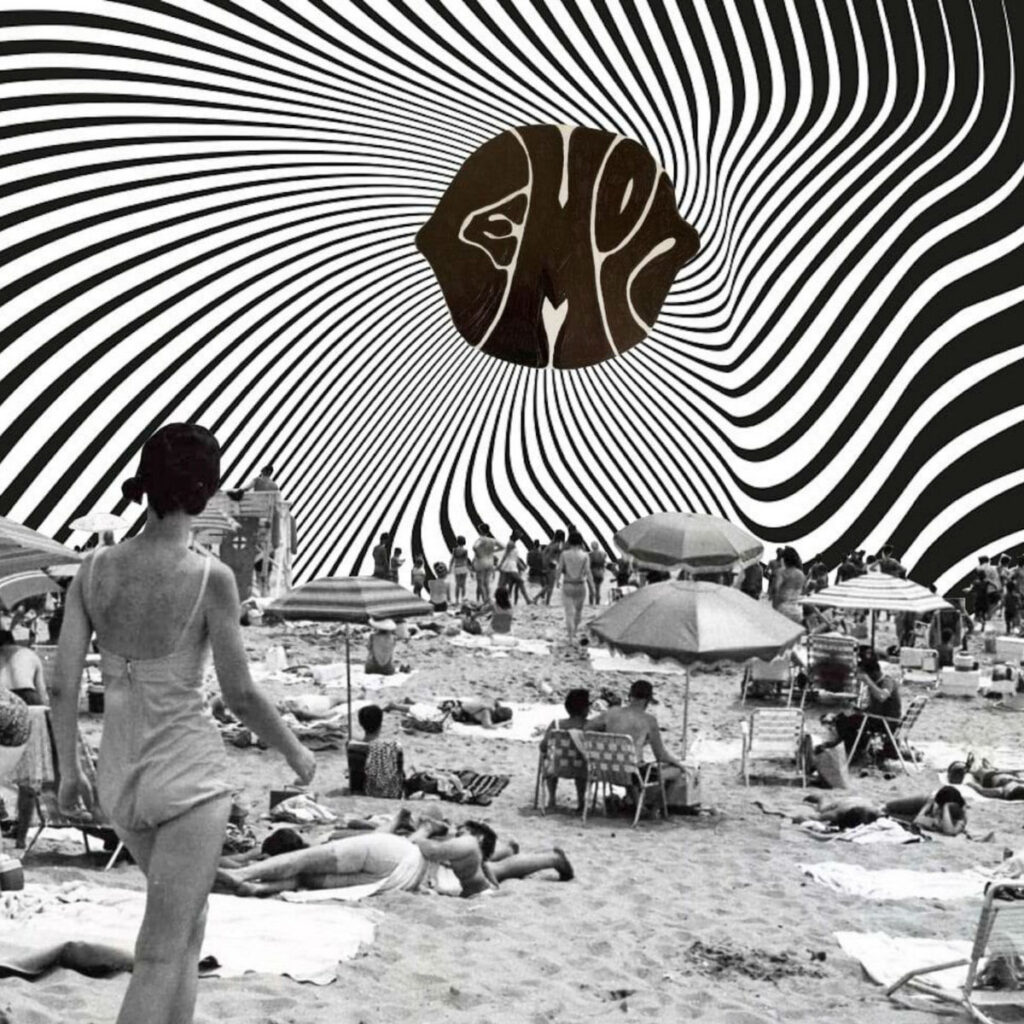
Chris: ‘Good Vibrations’ was a different lineup and the EP was mainly Ben and I recording most of the parts. We didn’t have any plans to fully become a band at that point, it was just three friends playing and recording together for fun. The drummer was my best friend from high school and we had just met Ben a few months prior and basically just all jammed together until we realized we had enough songs worth recording.
And what’s ‘Look Outside’? There’s not much info on it—was it a lost release, a live session, or something else entirely?
Ben: ‘Look Outside’ was Neon Lemon’s second record (there’s a lost self-titled one too), and it was all me before anyone had joined. It was recorded in 2020. It was mixed by Jonas Wilson at Mr. Pink Record, so I put that out on my own hoping to have a band sometime. Then when the band started to progress and Chris joined, I eventually decided to take it off Spotify and start over again. So there is that release, and there is also a release before that and a third I may have on a hard drive somewhere. Look Outside was pressed on a 12-inch vinyl, something like 100 copies, and I eventually sold out over the years.
Austin has had its share of legendary underground spaces—what’s the live scene like now? Are there venues or DIY spots keeping that spirit alive?
Chris: The overall price of living in Austin has definitely made an impact on artists living here, but even though some of us have had to move outside of Austin, we are still active in the city and we still thrive even though it’s not necessarily the best place to thrive anymore. It’s still beautiful in its own way. Nothing is going to kill the underground scene.
Ethan: The DIY scene is mostly younger kids now. I think everything sort of died off with COVID, so it was totally dead, and now it’s starting up again but from the grassroots. Great bands come out of the student housing co-ops in West Campus, current bands like Grocery Bag, Modern Form, and Witches Exist. Rents in Austin went totally nuts during COVID as many Californians moved here, but now the real estate market is crashing, so I think the DIY scene will continue to get more robust over the next couple of years. That’s just a guess though. We are really spoiled being from Austin because the bar we have for what our music scene should be is super high, because that is what it has been historically. Young people from all over are constantly moving to Austin with the dream of just being poor and playing music, so I guess in that sense we are living the dream.
Cody: There are venues, but they don’t represent artists, and they don’t pay artists, let’s be honest. The Inner Chamber was the last spot. Everything else is a scam. I don’t want to be so cynical, but the DIY scene post-COVID is the weakest it’s ever been. The cost of living is far too high to ever keep a consistent schedule of shows ourselves. Venues don’t pay us money.
Shawn: In the last ten years a lot of the special spots that made Austin what it was have sadly been slowly shutting down. I think the tech trade came to central Texas and messed everything up. It shot up the prices here very quickly and brought in a lot of lame people with no culture with it. And because it got pricey, the older places that were awesome couldn’t afford rent anymore. So they tore down most of the cool spots to build condos for the lame-ass people who are ruining the town in the first place. It’s not really the venues doing the cool stuff anymore unfortunately, but there are groups of people and musicians who are working hard to still make sure cool stuff happens and the spirit stays alive. It does seem like there is a resurrection happening. Usually if you make cool things happen people will come, it’s just about having the right-minded people setting up a cool scene again. The Inner Chamber was the last cool spot. We need more places run by artists, not just businessmen. Unfortunately most artists are broke so it makes it a bit hard to start things in an expensive town. Hopefully we can eventually get some support from the city or an organization to financially support a cool venue, but we’ll keep setting up our own cool DIY stuff until that day.
“The music was fly, the drugs were great, and the chicks were groovy.”
If you could time-travel back to any era in music history, where would you go and why? And while we’re at it, who’s on your ultimate dream jam session lineup?
Ben: If I could go back to a time in music and just jump in making music with people, it would be 1964 to 1967. Whatever Dr. John and the group were onto in 1968, Os Mutantes in 1968, The Beat of The Earth in 1967, The Monks in 1964, Brian Wilson making Pet Sounds in 1966, The Velvets in 1967, Sandy Bull ‘E pluribus Unum’ in 1969, The Impressions ‘Keep on Pushing’ in 1964, Pink Floyd ‘Piper at the Gates of Dawn’ era 1967, Elevators 1965, The Ronettes ‘Be My Baby’ and Phil Spector 1963, Brigitte Bardot and Serge Gainsbourg 1968. To name a few favorites I suppose.
Chris: I would go back to the early 60s if I had my knowledge of psychedelic music and really be able to revel in the blues era of psychedelic music, like, you know, early Rolling Stones, Bob Dylan going electric, early stuff, like all of the early 1962 to 1965 era would have been cool to really lay it down. My dream jam session lineup is honestly people that I have met in my lifetime all getting together and jamming at the same time, no stars.
Ethan: If anything, I would time travel forward to right now making myself 20 years younger, with all the naivety of youth. Everyone has all access to music history now, so in a way the musicians are super educated, and I think people are so past the internet that we are past that stage where people are just mimicking older bands. My ultimate dream jam session, I would answer two ways. One, I would say there was a show with 77 drummers in New York City, and I wish I could have been a part of that jam. But also, if I am just picking who I would want to jam with, I would probably say give me James Brown’s drummer Clyde Stubblefield, Jimi Hendrix on guitar, Miles Davis going nuts on trumpet, me on bass, and Ozzy Osbourne on vocals.
Cody: Time travel right now take me back to 1955 to the Beehive where Clifford Brown and Max Roach are just absolutely cooking. They are just blowing your mind with the craziest stuff you ever heard, that’s hot. I’d love to see that. Either that or, I forget the year, but the live performance Ugetsu by Art Blakey and the Jazz Messengers when he toured Japan for the first time. Dream lineup: I’d be a fool not to have Prince on there just doing whatever he wants really. I’d probably take Hildegard von Bingen on vocals, Terry Riley would be playing keys for sure, and Billy Cobham would be on drums. I’d have Tony Levin on bass, John McLaughlin on guitar, and Coltrane on horns.
Shawn: It’s a hard choice, it would probably be between the UFO Club, the Vulcan Gas Company, or the Fillmore West. Because the music was fly, the drugs were great, and the chicks were groovy. Jam session… that’s a hard one. Damo Suzuki from CAN on vocals, Nick Mason from Pink Floyd on drums, Manuel Göttsching from Ash Ra Tempel on guitar, Al Cisneros from Sleep on bass, and Ray Manzarek from The Doors on organ.

What’s next for Neon Lemon? Any future releases, tours, or collaborations in the works?
We have a 7” coming out soon on the English label Feral Child. The tracks are called ‘Sunflower’ and ‘Higher than Heaven’ and are our first recordings with the current lineup. They were recorded with Xavier Juarez at Wall of Fog here in Austin and mixed and mastered by Kate Derringer at High Bias Recordings in Detroit. She plays bass in the great Detroit band Shadow Show, check them out! We’re on another Texas tour and have the material to record a full length sometime this year. We’re still actively working with Mr. Franklin and something recorded may come out of that collaboration soon, but we gotta play it kind of coy for now!
Klemen Breznikar
Headline photo: Nicholas Kwasny
Neon Lemon Instagram / Bandcamp
Feral Child Recordings Facebook / Instagram
